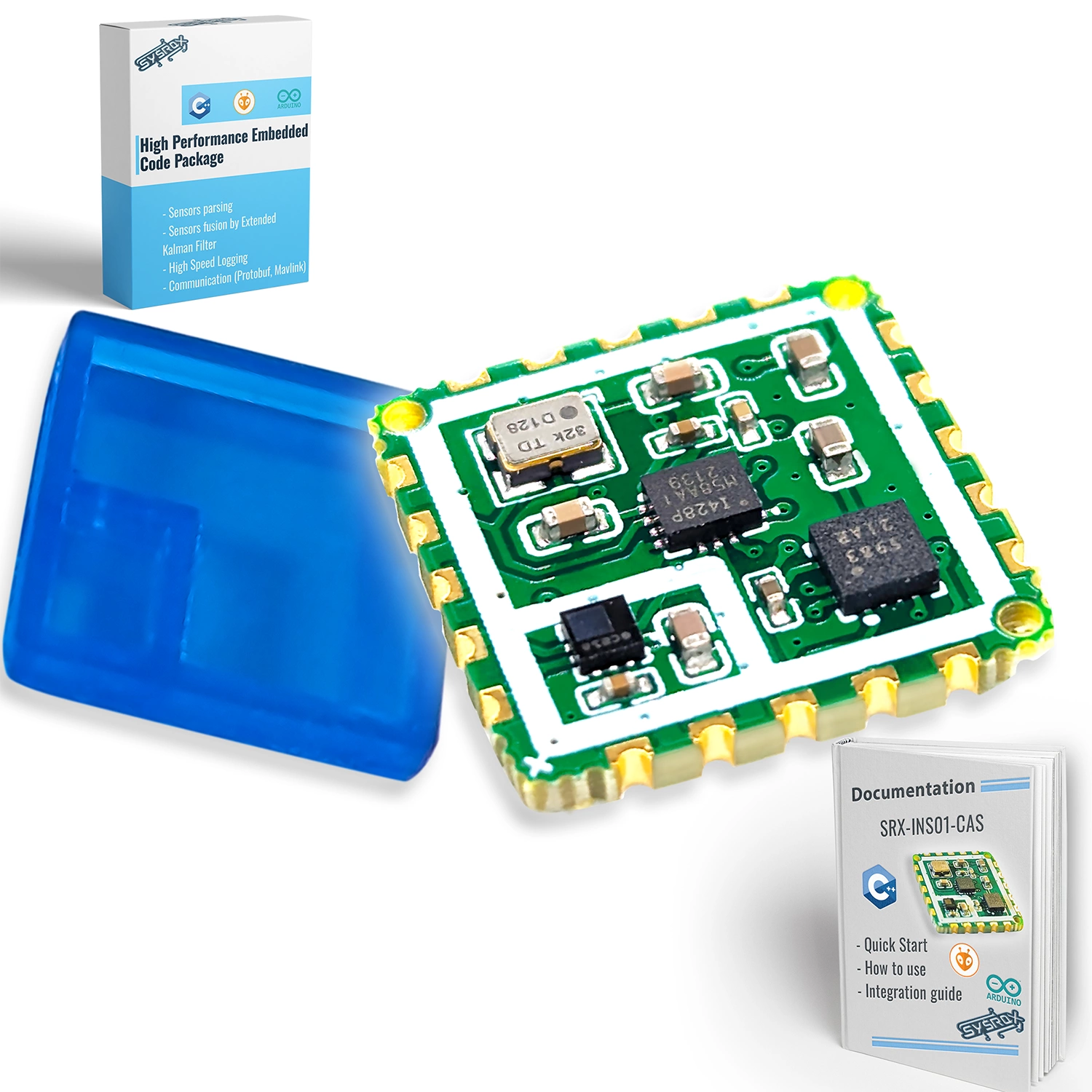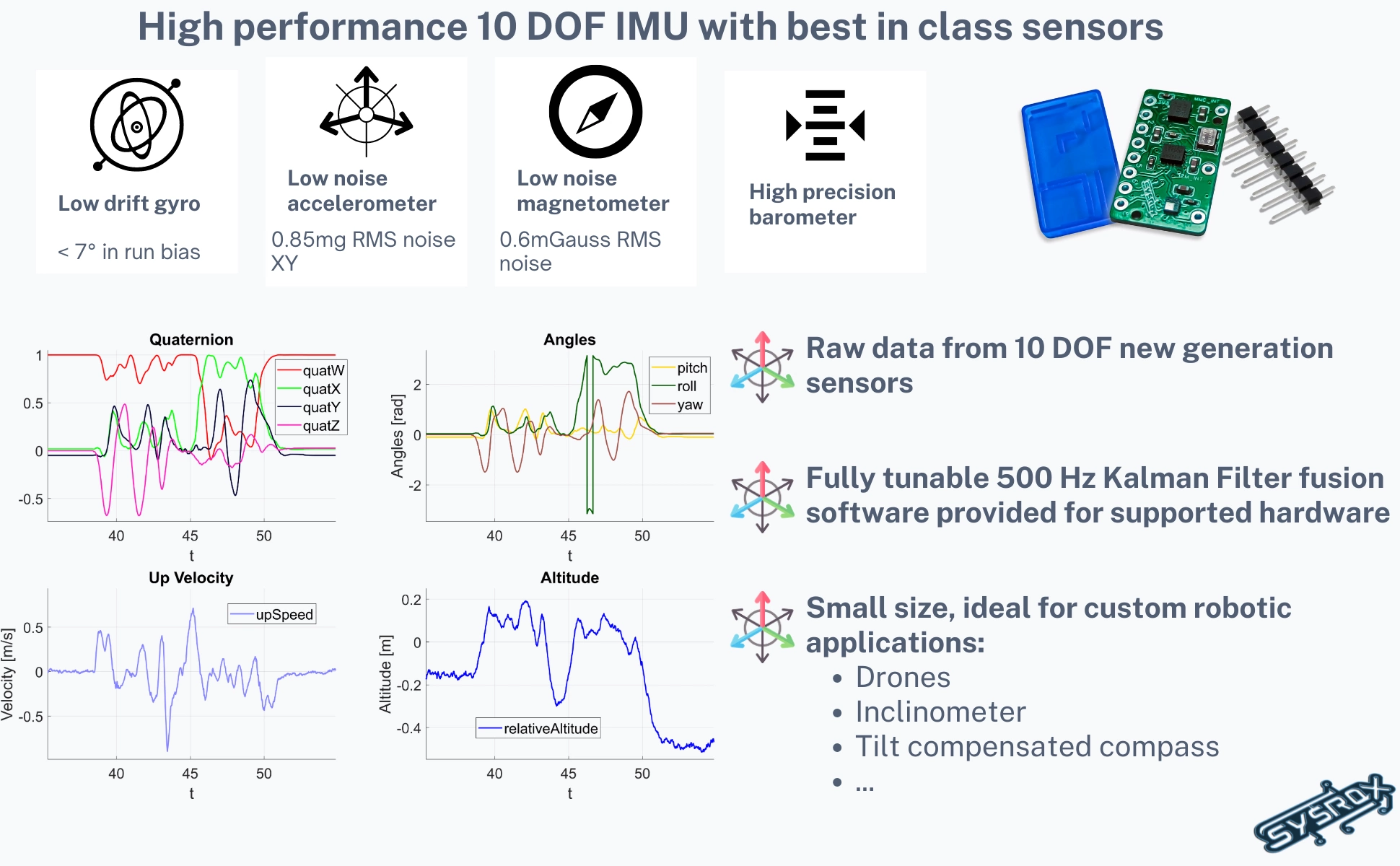10 DOF IMU sensors
10 DOF IMU modules are combinations of inertial measurement unit with a 3-axis accelerometer and a 3-axis gyroscope, augmented with a 3-axis magnetometer and a barometer on the same board. These modules are commonly found in various devices such as airplanes, drone stabilization systems, helicopters, and robots. They provide essential data about relative and absolute orientation, acceleration, angular velocity, altitude, and more. Thanks to the addition of the magnetometer and barometer, they are suitable for applications with a GPS, providing data propagation in GPS-denied environments, and enabling high-frequency and precise motion tracking and control in a wide range of applications.
- Code available:
- Accelerometer, Gyroscope, barometer and magnetometer sensors parsing
- Tunable 10 DOF sensors fusion through extended Kalman Filter (absolute and relative attitude, linear accelerations, vertical states ...)
- Fast SD card logging for supported hardware (ESP32, teensy 4.X)
- Communication (Mavlink, Protobuf, CAN) for supported hardware
- Real-time frequency analysis using FFT: 7 windowing options available
%20--%3e%3c!DOCTYPE%20svg%20PUBLIC%20'-//W3C//DTD%20SVG%201.1//EN'%20'http://www.w3.org/Graphics/SVG/1.1/DTD/svg11.dtd'%3e%3csvg%20version='1.1'%20id='Layer_1'%20xmlns='http://www.w3.org/2000/svg'%20xmlns:xlink='http://www.w3.org/1999/xlink'%20x='0px'%20y='0px'%20width='306px'%20height='344.35px'%20viewBox='0%200%20306%20344.35'%20enable-background='new%200%200%20306%20344.35'%20xml:space='preserve'%3e%3cpath%20fill='%2300599C'%20d='M302.107,258.262c2.401-4.159,3.893-8.845,3.893-13.053V99.14c0-4.208-1.49-8.893-3.892-13.052L153,172.175%20L302.107,258.262z'/%3e%3cpath%20fill='%23004482'%20d='M166.25,341.193l126.5-73.034c3.644-2.104,6.956-5.737,9.357-9.897L153,172.175L3.893,258.263%20c2.401,4.159,5.714,7.793,9.357,9.896l126.5,73.034C147.037,345.401,158.963,345.401,166.25,341.193z'/%3e%3cpath%20fill='%23659AD2'%20d='M302.108,86.087c-2.402-4.16-5.715-7.793-9.358-9.897L166.25,3.156c-7.287-4.208-19.213-4.208-26.5,0%20L13.25,76.19C5.962,80.397,0,90.725,0,99.14v146.069c0,4.208,1.491,8.894,3.893,13.053L153,172.175L302.108,86.087z'/%3e%3cg%3e%3cpath%20fill='%23FFFFFF'%20d='M153,274.175c-56.243,0-102-45.757-102-102s45.757-102,102-102c36.292,0,70.139,19.53,88.331,50.968%20l-44.143,25.544c-9.105-15.736-26.038-25.512-44.188-25.512c-28.122,0-51,22.878-51,51c0,28.121,22.878,51,51,51%20c18.152,0,35.085-9.776,44.191-25.515l44.143,25.543C223.142,254.644,189.294,274.175,153,274.175z'/%3e%3c/g%3e%3cg%3e%3cpolygon%20fill='%23FFFFFF'%20points='255,166.508%20243.666,166.508%20243.666,155.175%20232.334,155.175%20232.334,166.508%20221,166.508%20221,177.841%20232.334,177.841%20232.334,189.175%20243.666,189.175%20243.666,177.841%20255,177.841%20'/%3e%3c/g%3e%3cg%3e%3cpolygon%20fill='%23FFFFFF'%20points='297.5,166.508%20286.166,166.508%20286.166,155.175%20274.834,155.175%20274.834,166.508%20263.5,166.508%20263.5,177.841%20274.834,177.841%20274.834,189.175%20286.166,189.175%20286.166,177.841%20297.5,177.841%20'/%3e%3c/g%3e%3c/svg%3e)
10 DOF ahrs imu: accelerometer gyroscope magnetometer barometer icm-42688 mmc5983ma lps22hb SPI Castellated Board for Arduino or Raspberry
- Compact castellated board with glue-on cover included perfect for host board soldering
- Best in class sensors integrated: Accelerometer/Gyroscope icm-42688-p, magnetometer mmc5983ma, barometer lps22hb
- High precision tcxo quartz reducing gyroscope drift to less than 7° in run bias
- Fully customizable software with extensive documentation
10 DOF ahrs imu: accelerometer gyroscope magnetometer barometer icm-42688 mmc5983ma lps22hb SPI Breakout Board for Arduino or Raspberry
- Compact dev-board with glue-on cover included
- Best in class sensors integrated: Accelerometer/Gyroscope icm-42688-p, magnetometer mmc5983ma, barometer lps22hb
- High precision tcxo quartz reducing gyroscope drift to less than 7° in run bias
- Fully customizable software with extensive documentation
General FAQ
How are designed sensor boards?
Sensors are chosen based on their low noise level, low drift, high resolution and are integrated in the most convenient form factor for robotic applications development. If the board contains multiple sensors they are linked by a unique high speed SPI bus.
Are devices 5V tolerant?
No. Except if specified, all devices only supports 3.3V for power supply and communication, which allow more compact designs.
Do all devices come with software support?
Yes. Codebase is organised as libraries and applications linked by a manifest file. A project is composed by an application and necessary libraries. All sensors boards come with a C++ parsing library at minimum. 6dof and 10dof devices come with a sensors fusion code. All code is fully tunable and easy to integrate in your project.
What is supported hardware for C++ libraries?
All boards supporting Arduino Framework should be compatible with sensors parsing libraries. Some functionalities are only available on specific hardware like CAN communication (ESP32 only), logging (ESP32 and teensy 4.X)... Sensors fusion is hardware agnostic and should supported on all platforms. As it is distributed as precompiled .a file, do not hesitate to Contact US if you need support for a specific platform.
What are the requirements for 10dof sensors fusion?
As the fusion algorithm is based on an Extended Kalman Filter, it requires high computational power. It is recommended to use a microcontroller with a FPU (Floating Point Unit) like ESP32 or Teensy 4.X. Generally we recommend to use a microcontroller with at least the computational power of one ESP32 core.
What does include documentation?
The documentation includes a quick start guide for every device. For each library a detailed API documentation is provided with examples of how to use it with any project. For sensors fusion, a detailed explanation of the algorithm is provided and a tuning guide is proposed.
Where are devices with included microcontrollers?
These boards are currently tested and should be available in the near future. 2 models are currently developped featuring a dual core ESP32-S3 with wifi and bluetooth capabilities. The most advanced model will include CAN transceiver, GPS module with antenna, SD card slot and advanced power management.






